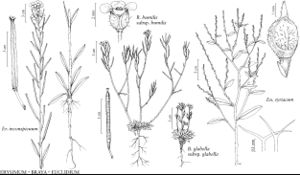Euclidium
in W. Aiton and W. T. Aiton, Hortus Kew. 4: 74. 1812.
Annuals; not scapose; scabrous, trichomes stalked, 2-forked, submalpighiaceous, mixed with fewer, simple, and, rarely, 3-forked ones, usually different sizes. Stems erect or ascending, unbranched or branched. Leaves basal and cauline; petiolate, sessile, or subsessile; basal (often withered by flowering), not rosulate, petiolate, blade margins entire, dentate, or repand, rarely pinnatifid; cauline sessile or subsessile, blade similar to basal, margins entire, dentate, or repand. Racemes (corymbose), elongated in fruit. Fruiting pedicels erect, stout. Flowers: sepals ovate to oblong; petals white, narrowly spatulate, (slightly longer than sepals), claw slightly differentiated from blade (shorter than sepals, apex emarginate); stamens slightly tetradynamous; filaments not dilated basally; anthers ovate, (apiculate); nectar glands (4), lateral, 1 on each side of lateral stamen. Fruits silicles (nutletlike), indehiscent, sessile, ovoid, subterete to slightly 4-angled; valves not veined, (thickened, woody), scabrous; replum strongly expanded laterally; septum complete, (thickened); ovules 2 per ovary, (subapical); style (persistent), obsolete or distinct; stigma capitate, 2-lobed (lobes not decurrent). Seeds aseriate, plump, not winged, oblong; seed-coat (smooth), not mucilaginous when wetted; cotyledons accumbent or obliquely so.
Distribution
Introduced; e Europe, c, w Asia, also in Australia
Discussion
Species 1.
Selected References
None.
Lower Taxa
"elongated" is not a number."thick" is not a number.
